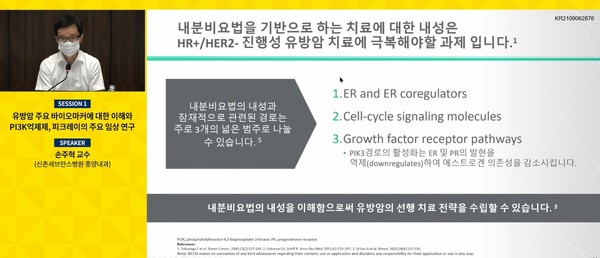Novartis Korea has introduced its combination therapy of Piqray (ingredient: alpelisib) and fulvestrant, saying it could prolong the treatment period and overall survival (OS) of breast cancer patients with major genetic mutations.
In May, the company’s breast cancer drug received approval from the Ministry of Food and Drug Safety for treating patients with hormone receptor (HR) positive, human epidermal growth factor receptor 2 (HER2) negative, and PIK3CA-mutated breast cancers.

Breast cancer is the leading cause of cancer-related deaths worldwide and the most common female cancer in Korea. Among breast cancer subtypes, patients with hormone receptor (HR) positive and human epidermal growth factor receptor 2 (HER2) negative breast cancers account for about 73 percent of all cases.
PIK3CA mutation was a frequent genetic change in about 40 percent of patients with HR-positive and HER2 negative advanced breast cancer and is associated with tolerance to endocrine therapy, disease progression, and poor prognosis.
Although PIK3CA mutation is the most common genetic mutation in breast cancer, there has been no effective treatment targeting it so far.
However, as therapeutic agents targeting the mutation have recently been introduced to the public, the European Society for Medical Oncology (ESMO) recommended checking for PIK3CA mutations along with the HER2 and Breast cancer gene (BRCA) mutations in breast cancer patients.
Piqray is a PIK3CA-specific inhibitor and blocks the excessive activity of the PI3K pathway by inhibiting the overactivation of PI3K-α caused by PIK3CA mutation. Novartis verified safety and efficacy in breast cancer patients through its phase 3 SOLAR-1 clinical trial and phase 2 BYLieve study.
The company conducted a global SOLAR-1 trial with 572 women and men with HR-positive or HER2 negative advanced or metastatic breast cancer treated under aromatase inhibitors.
Piqray plus fulvestrant combo therapy prolonged the median progression-free survival (PFS) for 11 months, almost double the 5.7 months shown in the fulvestrant monotherapy group.
The combination therapy also reduced the risk of disease progression and death by about 35 percent. The drug also showed potential for a long-term treatment as it maintained PFS for more than 24 months in three out of four patients who continued treatment for more than 18 months.
The overall response rate (ORR), representing the proportion of patients with a reduction in tumor size of at least 30 percent, reached 35.7 percent in the PIK3CA cohort with measurable disease.
The Piqray and fulvestrant therapy increased the OS of breast cancer patients to 39.3 months, extending by about eight months from 31.4 months in the control group.
In the phase 2 BYLieve study, Piqray also showed clinical effectiveness in patients with PIK3CA mutation. The study met the primary endpoint, reaching a 50.4 percent survival rate without progressing cancer and a median PFS of 7.3 months.
“Endocrine therapies are recommended and mainly used in only two types of all solid cancers, breast and prostate cancer, because of the toxicity of anticancer treatments,” Professor Sohn Joo-hyuk of the Department of Medical Oncology at Severance Hospital said in an online news conference. “Considering the quality of life and PFS of the patients, we have no other choice but to set endocrine therapy as the standard treatment.”
Sohn explained that the recent approval is valuable. Patients can expect more extended endocrine therapy mixed with Piqray and move on to further anticancer drugs later with a better prognosis.

